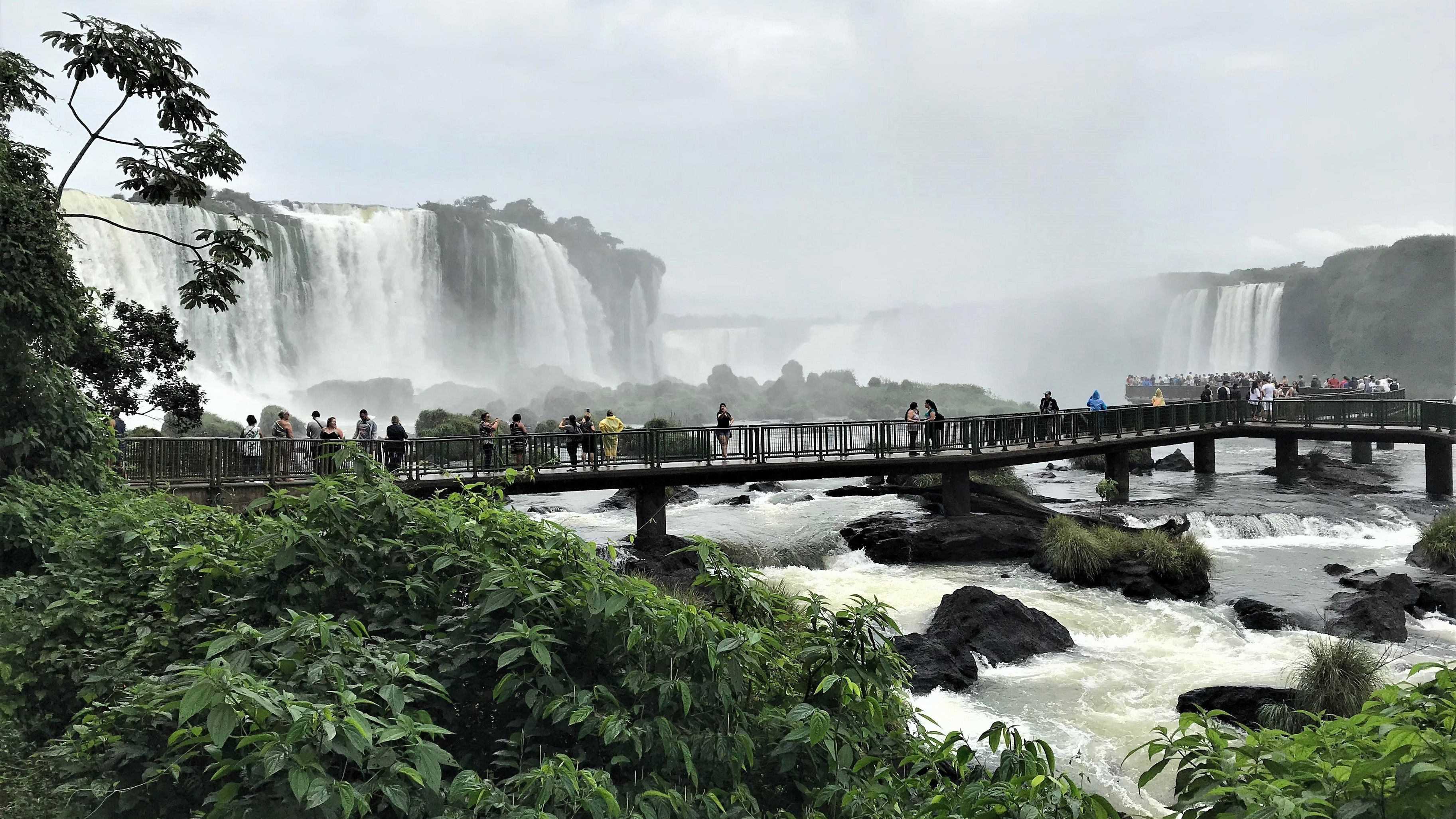
The grand Iguaçu Falls.
Credit: Photo by author
They say comparisons are odious, but visitors told us that these falls, known as Cataratas do Iguaçu, were even grander compared to Niagara Falls. This certainly piqued my interest. Some 275 waterfalls within a stretch of 2.7 km and a flow of 1.5 million litres of water per second. The numbers are impressive, and I wondered if looking at the falls in person would be as grandiose. Indeed, one of the most spectacular places during our three-week itinerary in Brazil was Foz do Iguaçu, a quaint town in the Parana district of Brazil that shares its borders with Paraguay and Argentina. It was an hour-and-a-half-flight from the Campinas, Viracopos Airport (VCP), Sao Paulo to the Cataratas International Airport in Foz do Iguaçu where we would spend two days.
While there are many worthy sites, visitors primarily come here to see the wondrous falls which are listed amongst the Seven Natural Wonders of the World. Foz do Iguaçu is so named because it sits at the mouth of the Iguaçu River and the name in Portuguese translates as that.
We left the next morning along with our guide to the falls which was a distance of 12 km from our hotel. The wonderful thing is that the area around the falls has been declared a National Park and is known as Parque Nacional do Iguaçu. It is Brazil’s second-oldest national park, created in 1939. It protects the Iguaçu Falls, which is part of the largest waterfall system in the world. It was in 1541 that Spanish Conquistador, Alvar Nunez Cabeza de Vaca, explored the region that we now know as Argentina and came across these falls. ‘Iguaçu’ means big water and the falls are indeed appropriately named. The site has been designated as a UNESCO World Heritage site and hunting, fishing and other forms of natural resource exploitation are banned in areas with this preservation status.
The guide drove us through the verdant national park to a point from where we had to trek to see the entire grandeur of the falls. Geographically the falls are on the border of Brazil and Argentina. The whole area boasts of 275 distinct waterfalls, in addition to large islands, and is one of the largest waterfalls in the world. As we trekked, the falls got bigger and more beautiful, and the foliage denser. If you are lucky you will also get to see birds like the Great Dusky Swift, which interestingly builds its nest behind the gushing water of the Iguaçu Falls. And, as we reached the end of the trail, I let out a shout of wonder and awe. While I was looking at the final curtain of falls that can be observed at close quarters, the spray of water just drenched me. This is the Devil’s Throat which consists of 14 falls in a U-shape, just like a horseshoe. We just didn’t want to leave the breathtakingly beautiful spot.
The common Argentinian and Brazilian border runs through the Devil’s Throat. The falls’ natural beauty and cultural importance, warranted its declaration as a UNESCO World Heritage Site in the mid-1980s. Half an hour from the town of Iguaçu is the famous landmark of the triple border of three South American countries. I had a child-like excitement when we were taken to this spot where the borders of three nations merge. The Iguaçu Falls are shared between three nations: Brazil, Argentina and Paraguay.
The triple border falls in the deepest part of the confluence of the Iguaçu and Parana rivers and is unmarked. But all three nations have erected monuments by building obelisks and painting them with the colours of their respective flags that overlook the spot. The Brazilian Marco das Tres Fronteiras (Three Borders Landmark) was erected in 1903 and gives the panoramic view of the three borders and the two-river confluence.
Itaipu Dam
The second day was devoted to seeing the other parts of Iguaçu. A half an hour’s
drive from the hotel got us to the Itaipu Hydroelectric Dam. We were taken by a shuttle bus to the dam as private cars are not allowed. It was stunning to see the wide dam that was built over the Parana River. I was not surprised to hear that it is the world’s second-largest operational hydroelectric power plant with nearly 90 percent being used by Brazil. We were told that this project was the outcome of a unique bi-national collaboration between Paraguay and Brazil. The proposal for the construction of the Itaipu Dam was made in February 1971 and by April 1973, Paraguay and Brazil signed a treaty to exploit the Parana River for generating and using hydroelectric power. Today, with a generation capacity of 14GW, Itaipu helps to meet the power demands of the two countries.
A Buddhist temple
Brazil is largely a Catholic country and it was quite surprising to find the Chen Tien Buddhist Temple, which belongs to the Mahayana School of Buddhism. We got to know that this was built by and for the Taiwanese Chinese who were commissioned to build the Itaipu Dam. The temple is located on the top of a hill with beautiful views of the cities of Foz do Iguaçu and Ciudad del Este.
The beautiful statues, garden and temple structure have an extremely calming effect on a visitor.
Spread across the area you find statues dedicated to the Three Buddhas (the Sakyamuni, the Amitabha, and the Laughing or Mila Pusa Buddha); Four Boddhisattvas (namely the Samantabhadra, Manjushri, Avalokiteshvara and Ksitagarba); Four Celestial Kings, Two
Enlightened Children, Eighteen Arahats (or the worthy ones) and the Guardian Lions.
The next stop from Foz do Iguaçu was Rio de Janeiro and I was carrying the memories of the grandeur of nature that Brazil is blessed with.